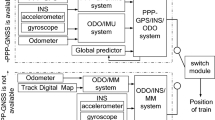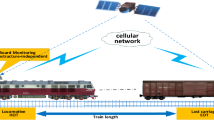Abstract
A new GNSS/IMU tightly coupled positioning system is introduced to train positioning. To fulfil a train control system’s aim of reducing the need to install trackside equipment, the GNSS precise point positioning (PPP) method is applied in place of the conventional differential GNSS method. As the railway environment has the character of long operational mileage and complex GNSS measurement conditions, the GPS and BDS constellations are combined with measurement processing to improve the system’s continuity and stability. Ultra-rapid GNSS orbit and clock product is used for real-time PPP. The GNSS-PPP and IMU are tightly coupled using an Extended Kalman filter with single-differenced ionospheric-free GPS + BDS carrier phase and pseudorange observations. The carrier phase ambiguities are estimated as “float” values every epoch to reduce the impact of GNSS signal loss-of-lock and cycle slips. A train experiment was conducted on the Qinghai-Tibet Railway to evaluate system performance. The results show that the proposed system has a better performance than the conventional methods, including GPS + BDS PPP, LC GPS + BDS PPP/IMU and TC GPS PPP/IMU, with 52.1%, 49.4% and 52.1%, respectively. The tightly-coupled GPS + BDS PPP/IMU system under conditions of partly blocked GNSS coverage was evaluated to evaluate the system's continuity. It was confirmed that the proposed system had more stable positioning results and higher positioning accuracy.

















Similar content being viewed by others
References
Acharya A, Sadhu S, Ghoshal TK (2011) Train localization and parting detection using data fusion. Transp Res Part C Emerging Technol 19(1):75–84
Boehm, J., Niell, A., Tregoning, P., Schuh, H. (2006) Global Mapping Function (GMF): a new empirical mapping function based on numerical weather model data. Geophys Res Lett, 33(7)
Carvajal-Carreño W, Cucala AP, Fernández-Cardador A (2016) Fuzzy train tracking algorithm for the energy efficient operation of CBTC equipped metro lines. Eng Appl Artif Intell 53:19–31
China Railway (2008) General Technical Scheme of CTCS-3 Train control System, Beijing, China
Du S, Gao Y (2012) Inertial aided cycle slip detection and identification for integrated PPP GPS and INS. Sensors 12(11):14344–14362
Duan B, Hugentobler U, Chen J, Selmke I, Wang J (2019) Prediction versus real-time orbit determination for GNSS satellites. GPS Solut 23(2):39–48
Durmus MS, Takai S, Soylemez MT (2014) Fault diagnosis in fixed-block railway signaling systems: a discrete event systems approach. IEEJ Trans Electr Electron Eng 9(5):523–531
Ernest, P., Mazl, R., Preucil, L. (2004) Train locator using inertial sensors and odometer. In: IEEE intelligent vehicles symposium, Parma, Italy, pp. 860–865
Gao Z, Ge M, Shen W, Li Y, Chen Q, Zhang H, Niu X (2017) Evaluation on the impact of IMU grades on BDS+GPS PPP/INS tightly coupled integration. Adv Space Res 60(6):1283–1299
Groves, P. D. (2013) Principle of GNSS, Kalman filter-based estimation in Inertial and Multisensor Integrated Navigation Systems. Artech House: London
Guo J, Xu X, Zhao Q, Liu J (2016) Precise orbit determination for quad-constellation satellites at Wuhan University: strategy, result validation, and comparison. J Geodesy 90(2):143–159
Gurník P (2016) Next Generation Train Control (NGTC): more effective railways through the convergence of main-line and urban train control systems. Transp Res Procedia 14:1855–1864
Hauschild A, Montenbruck O, Sleewaegen J, Huisman L, Teunissen P (2012) Characterization of compass M-l signaIs. GPS Solut 16(2):117–126
Heirich, O. (2016) Bayesian train localization with particle filter, loosely coupled GNSS, IMU, and a track map. J Sens, 1–15.
Jiang W, Chen S, Cai B, Rizos C, Wang J, Shangguan W (2020) An analysis of PPP-GPS-GPS-based decentralized train multi-sensor navigation system. GPS Solut 24(3):67–80
Jiang W, Li Y, Rizos C (2015) Locata-based precise point positioning for kinematic maritime applications. GPS Solut 19(1):117–128
Jin C (2019) Research on train precise point positioning method for train control system. Dissertation. Beijing Jiao Tong University
Kim K, Kong S, Jeon S (2015) Slip and slide detection and adaptive information sharing algorithms for high-speed train navigation systems. IEEE Trans Intell Transp Syst 16(6):3193–3203
Kouba J, Héroux P (2001) Precise Point Positioning using IGS orbit and clock products. GPS Solut 5(2):12–28
Landau, H., Chen, X., Klose, S., Leandro, R., Vollath, U. (2007) Trimble’s RTK and DGPS solutions in comparison with precise point positioning, observing our changing earth. In: international association of Geodesy Symposia, Perugia, Italy, July 2–13, 709–718
Li K (2005) Plan of ITCS signal control system on Qinghai-Tibet railway. Chin Railw 7:31–36
Li Z, Gao J, Wang J, Yao Y (2017) PPP/INS tightly coupled navigation using adaptive federated filter. GPS Solut 21(1):137–148
Liu S, Sun F, Zhang L, Li W, Zhu X (2016) Tight integration of ambiguity-fixed PPP and INS: model description and initial results. GPS Solut 20(1):39–49
Liu, D., Jiang, W., Cai, B., Wang, J., Shangguan, W. (2019) A Tightly-Coupled GNSS/INS/MM integrated system based on binary search algorithm for train localization applications. In: 32nd international technical meeting of the satellite division of the institute of navigation (ION GNSS+ 2019), Miami, Florida, USA, Sept. 16-20, pp. 1272–1283
Lu D, Tang D, Spiegel D (2020) Hazard rate estimation for gnss-based train localization using model-based approach. Chin J Electron 29(1):49–56
Meng, Y., Gao, S., Wei, W. (2016) Unscented particle filter based Gaussian process regression for IMU/BDS train integrated positioning Information Technology. In: 2016 IEEE information technology, networking, electronic & automation control conference, Chongqing, China, pp. 1070–1073
Neri, A., Sabina, S., Mascia, U. (2015) GNSS and odometry fusion for high integrity and high availability train control systems. In: 28th GNSS and odometry fusion for high integrity and high availability train control systems, Tampa, FL, USA, pp. 639–648
Next Generation Train Control (2014) D2.2 High Level Comparison between Operational Models, Seventh framework programme
NovAtel Inc. (2015a) SPAN IMU-FSAS User Manual, Calgary, Alberta, Canada
NovAtel Inc. (2015b) SPAN on OEM6 Firmware Reference Manual, Calgary, Alberta, Canada
Rabbou MA, El-Rabbany A (2015) Tightly coupled integration of GPS precise point positioning and MEMS-based inertial systems. GPS Solut 19(4):601–609
Saastamoinen J (1973) Contribution to the theory of atmospheric refraction. Bull Geodesique 107:13–34
Tamba TA, Nazaruddin YY (2019) On input-to-state stability of train platoon under moving block signaling. IFAC PapersOnLine 52(15):336–339
Wanninger L (2009) Correction of apparent position shifts caused by GNSS antenna changes. GPS Solut 13(2):133–139
Xu A, Xu Z, Xu X, Zhu H, Sui X, Sun H (2014) Precise Point Positioning using the regional Beidou navigation satellite constellation. J Navig 67(3):523–537
Yang S, Li L, Liu J, Chen Q, Ding X, Sun H, Wu Y, Ren C, Hu N (2019) Effective cycle slip detection and repair for PPP/INS integrated systems. Sensors 19(3):502
Yuan Y, Mi X, Zhang B (2020) Initial assessment of single- and dual-frequency BDS-3 RTK positioning. Satell Navig. https://doi.org/10.1186/s43020-020-00031-x
Zhang B, Hou P, Zha J, Liu T (2022) PPP–RTK functional models formulated with undifferenced and uncombined GNSS observations. Satell Navig. https://doi.org/10.1186/s43020-022-00064-4
Zhang Z, Liu X, Holt K (2018) Positive Train Control (PTC) for railway safety in the United States: policy developments and critical issues. Utili Policy 51:33–40
Zhao Q, Guo J, Wang C, Lyu Y, Xu X, Yang C, Li J (2022) Precise orbit determination for BDS satellites. Satell Navig. https://doi.org/10.1186/s43020-021-00062-y
Acknowledgements
This work was supported by National Natural Science Foundation under Grant U1934222.
Author information
Authors and Affiliations
Corresponding author
Additional information
Publisher's Note
Springer Nature remains neutral with regard to jurisdictional claims in published maps and institutional affiliations.
Rights and permissions
About this article
Cite this article
Jiang, W., Liu, M., Cai, B. et al. An accurate train positioning method using tightly-coupled GPS + BDS PPP/IMU strategy. GPS Solut 26, 67 (2022). https://doi.org/10.1007/s10291-022-01250-2
Received:
Accepted:
Published:
DOI: https://doi.org/10.1007/s10291-022-01250-2




